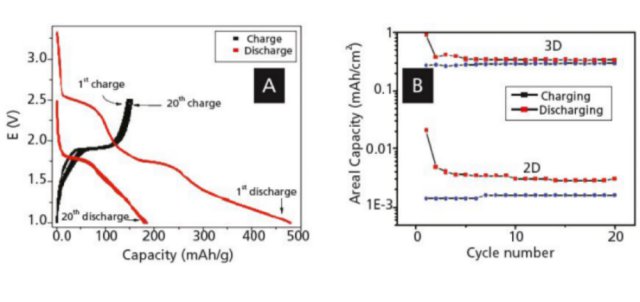 The US Air Force Research Laboratory, Wright- Patterson Air Force Base, Ohio has just published a new paper on Electrochemical Energy Storage Materials.
The US Air Force Research Laboratory, Wright- Patterson Air Force Base, Ohio has just published a new paper on Electrochemical Energy Storage Materials.
Applications include small, autonomously powered, remotely piloted aircraft; airfield support; deployed airbase power; and portable soldier power.
One of the most important requirements in next-generation batteries is to concurrently deliver high energy density and high power density (fast charge-discharge rates). The high power density requirement can be met with enhanced ion and electron transport kinetics in batteries, which in turn requires active materials with high ion diffusion constants and conductive additives or architectures for faster electron transport to respective current collectors. It is well known that nanostructuring the electrode materials would significantly enhance the characteristic time constant for ion diffusion, thereby reducing the intercalation/deintercalation time.
However, nanostructuring electrode materials leads to some issues such as reduced electron transport kinetics through interparticle boundaries, and undesired side reactions due to high electrode/electrolyte surface area. In nano structured electrode materials studies, three-dimensional (3D) conducting nano-architectured current collectors were chosen (e.g., electrodeposited Ni nanowire arrays), and they were coated with ultrathin conformal layers of active materials to circumvent the reduced electron transport kinetics issue. To get around the side reactions due to high electrode/electrolyte surface area, active materials and electrolytes may be suitably chosen that are least reactive, such as TiO2, which is not known to form a solid electrolyte interphase (SEI).
Atomic layer deposition (ALD) was chosen as a process to conformally coat the 3D current collector nano-architecture with nanometer-scale control over active layer thickness. Thus the Li-ion diffusion in active electrode material is limited to a couple of nanometers, and electron conducting current collector is in contact with the ultrathin active layer everywhere. Such 3D designs can achieve the ultimate goal of 3D all-solid-state microbatteries by sequentially assembling an anode (cathode) layer followed by a solid electrolyte/separator, and then the complementary cathode (anode) filling the space in between the nanowires. All-solid-state 3D microbatteries will be crucial to successful operation of many miniaturized autonomous devices with significant interest to future Air Force needs.
Despite the fact that nanostructuring of battery electrodes can increase battery power density, the 2D planar design fundamentally limits the amount of energy that can be stored and power that can be delivered per unit area, mass, and volume. The 3D battery architectures exploit the advantages of nano – structuring, while potentially decreasing the areal footprint of a 2D design. In this task, a variety of potential 3D designs was pursued that are generally composed of a 3D matrix of the electrodes (periodic or aperiodic) in order to maximize the number of interfaces and thus interfacial reactions in the battery. Although transport between the electrodes remains 1D, the additional interfaces that are interpenetrated in the 3D network offer major gains in the areal footprint, while the 3D design minimizes transport distances between and in the electrodes, which can result in higher power densities.
The fabrication and processing methodologies for battery electrodes are being developed that can be implemented to coat 3D architectures with micron and nanosized features. Atomic layer deposition (ALD) is a gas phase, self-limiting growth technique that allows for uniform, conformal growth of thin films on 3D structures using sequential surface reactions. A low-temperature ALD (LT-ALD) process was developed in order to deposit conformal and uniform films of amorphous SnOx on CNTs, as well as a hightemperature (HT-ALD) process to deposit nanoparticles of Sn and SnO. Morphological and electrochemical analyses were conducted to provide a detailed understanding of the complex architecture of the hybrid electrodes and how this relates to their device performance.
The capability to create distinctly different forms of the hybrid SnOx–carbon anode material was demonstrated— either nanoparticles attached directly to the carbon nanotubes or as a conformal coating. The measured specific capacities of the SnOx-buckypaper composites are quite high and are considerably higher than graphite itself. Importantly, for small particle sizes, the specific capacity was shown to be greater than the theoretical capacity for Sn (Li4.4Sn, 993 mAh/g), which suggests that nanosized particles of Sn have a larger solid solution range with lithium than bulk Sn particles. This observation could have important implications for designing even higher-energy-density systems.
This work was done by Michael F. Durstock, Benji Maruyama, and Patrick S. Carlin of the Air Force Research Laboratory; Gyanaranjan Pattanaik, Jacob M. Haag, Daylond Hooper, and Gordon Sargent of UES Inc.; Placidus Amama and Neal A. Pierce of the University of Dayton Research Institute; Rahul Rao of the National Research Council; and Kent Weaver of SOCHE Inc. AFRL-0220
To access the complete paper, click here and follow instructions at the end of the article.
Source: Defense Tech Briefs
